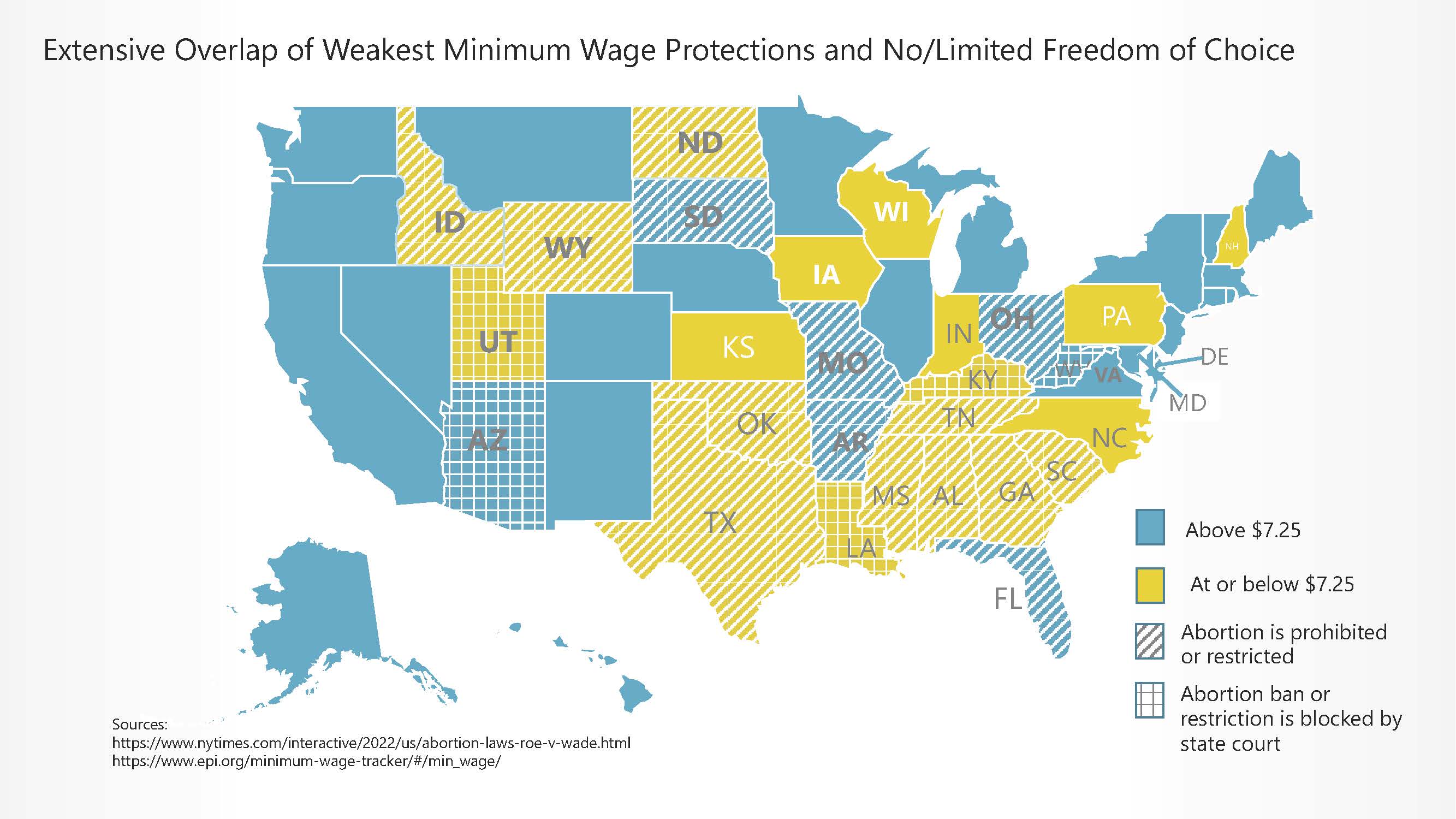
The Overlap of the $7.25 Minimum Wage and Abortion Restrictions

After the U.S. Supreme Court’s decision in Dobbs v. Jackson Women’s Health Organization, access to abortions has been banned or severely restricted in states across the U.S. According to the New York Times, abortion is or will soon be banned or restricted in at least 21 states (though, at the time of this writing, courts in 5 of those states have, at least temporarily, blocked the ban or restriction).
Access to abortions is fundamental to bodily autonomy, reproductive justice, and gender equality. The right to choose when and if to have a child is also a workers’ rights issue that is inherently linked to the economic well-being of anyone who can become pregnant. As U.S. Secretary of Labor Marty Walsh stated, “reproductive autonomy directly supports women’s ability to get an education, participate in the labor force, and increase their earning potential and it has helped to narrow the gender wage gap. Losing the right to reproductive freedom will have a catastrophic impact on women’s employment and economic security.”
Studies done prior to the Dobbs decision found that the denial of an abortion increased the likelihood of poverty and financial distress. Today, many of the same states that are stripping their residents of bodily autonomy also allow employers to pay their workers poverty-level wages. As the above map shows, there is considerable overlap with those states that have banned or curtailed the right to choose and the 20 states that continue to use the federal minimum wage as their legal wage floor.
What’s the problem with the federal minimum wage?
The federal minimum wage has not been increased since 2009 when Congress raised it to $7.25 per hour. Since then, federal dysfunction has resulted in the longest period in history without a raise. Of course, while the minimum wage has stagnated, inflation has not. In June 2022, the same month the Dobbs decision was issued, inflation rose 9.1% from the previous year, the largest 12-month increase since 1981. Thus, sky-high inflation has forced working people in 20 states to provide for themselves and their families with a wage that is worth 27% less today than it was 2009.
Many of the states that have taken away or restricted access to abortions have minimum wage rates so low, they condemn a sole minimum wage earner who has just one child to poverty. A person working full-time earning $7.25 per hour makes about $15,000 annually. Federal poverty guidelines—which have widely been deemed to be an inadequate measure of economic security in the U.S.—estimate poverty for a two-person household to be $18,310. (Other more comprehensive measures calculate that a single adult without children needs at least $31,200 per year to cover basic costs of living anywhere in the U.S.)
Disparate impacts of Dobbs and inadequate minimum wages
The harms caused by poverty-level minimum wages and curtailed access to legal abortions will not be borne equally. Women, particularly women of color, are overrepresented in minimum wage jobs. More than two in three minimum wage workers across the U.S. are women, while 50% of working women of color earn less than $15 per hour. Further, advocates note that women of color, particularly in states where abortions are restricted, often face inadequate access to healthcare and effective birth control. Prior to Dobbs, this meant that women of color received abortions at higher rates. As the Justices Breyer, Sotomayor, and Kagan pointed out in their dissenting opinion, women living below the poverty line experience unintended pregnancies at rates five times higher than higher income women, and nearly half of women who seek abortions live in households below the poverty line. Likewise, poverty-level wages and abortion restrictions are concentrated in the South, the region with the highest concentration of Black people.
Thus, as part of the broader fallout from the Dobbs decision, the overlap of weak minimum wages and limited abortion access has the potential to compound gender, racial, and regional disparities in poverty rates across the U.S.


